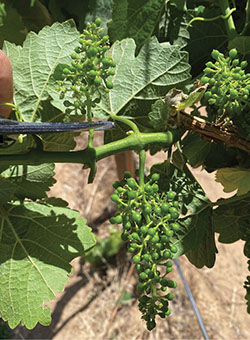Guide H-311
Revised by Gill Giese
College of Agricultural, Consumer and Environmental Sciences, New Mexico State University
Author: Extension Viticulture Specialist, Department of Extension Plant Sciences, New Mexico State University. (Print Friendly PDF)
Seedless grapes are popular among consumers, with about 8 lb per capita consumed each year in the United States. Seedless table grapes are commonly grown in home gardens and on small farms throughout New Mexico.
The vineyard site environment—soil, climate, and seasonal variation—influence the grape crop. However, many viticultural practices can be used to improve or manipulate fruit quality. These include cultivar and rootstock selection, fertilization, irrigation, weed and pest control, kaolin clay application, hormones, training, pruning, trunk girdling, and cluster thinning.
These practices can be used to improve fruit size and quality of seedless table grapes. Several suggested practices and field trial results are referenced here. Keep in mind that combining practices within the same growing season can maximize results.
Pruning
Crop load is defined as the amount of fruit per vine. Viticulturists should strive for a vine with leaf canopy that is adequate to support the intended crop load to the desired degree of ripeness. However, “over-cropping” should be avoided. Excessive fruit load or over-cropping is defined as allowing more fruit to set than the vine can ripen to the desired degree of maturity. Over-cropping often leads to small berry size, poor color, late maturity, and low total soluble solids or TSS (related to sugar content). Removing or thinning the fruit from over-cropped vines can increase berry size and improve berry composition of the remaining clusters. Follow recommended pruning practices for a given variety. Pruning is your first annual opportunity to determine crop load. If you plan to use additional practices later in the season, such as trunk girdling or cluster thinning, leave an additional amount of fruiting wood on the vine when you prune. Doing so will allow you to select better clusters at thinning time (Figure 1).

Figure 1. Grapevine after pruning. One-half, cane pruned (left) and one-half, spur pruned (right). A and B indicate places for girdling.
Cluster Thinning
Seedless cultivars, such as ‘Thompson Seedless’ and ‘Black Monukka’, tend to over-crop, setting more clusters than the vine can properly mature. To remedy this situation, simply remove some of the excess clusters (Figure 2). Cluster thinning allows the photosynthates (simple sugars) produced by the leaves to better nourish the remaining clusters. Vine vigor and previous experience will help determine the number of clusters to leave per vine. However, a good starting point is to leave one cluster per shoot that has 12–17 mature leaves. If two or three clusters occur on a single shoot, remove the uppermost or most “distally” located cluster(s). After fruit set (the shatter stage, when flower parts are falling), remove clusters that are undersized, oversized, misshapen, or entangled with adjacent clusters. This is probably the most important step in improving grape quality.

Figure 2. Thinning clusters (one per shoot) to achieve about 20–40 clusters per vine, depending on overall size of the vine.
Berry Thinning
For additional fruit quality improvement of ‘Thompson Seedless’, ‘Black Monukka’, and other cultivars that produce very large or compact clusters, remove parts of the remaining clusters soon after cluster thinning. Remove about one-half of each cluster (the lower part of the rachis), leaving four or five branches near the cluster’s base where it attaches to the cane. The lower part of the cluster is usually compact, and the berries ripen later than those on the upper part (Figure 3).

Figure 3. Cluster at correct stage for berry thinning; when the berries are pea-sized or slightly smaller, remove the lower half of the cluster.
Girdling
Removing a small section of bark and phloem about 4–9 mm (about 1/6–1/3 inch) wide from around a cordon (arm), cane, or main trunk is known as “girdling” and has been practiced for many years to increase berry size and sugar content and improve berry color. Girdling is typically done soon after the shatter stage if an increase in berry size is desired. Some report success with the variety ‘Perlette’ when girdling is done one week before bloom with a 4-mm-wide (1/6 inch) ring around the main trunk.
Girdling usually increases the carbohydrates above the girdle, while root carbohydrates are decreased. Carbohydrates formed in the leaves via photosynthesis will remain in the area above the girdle/ring and will be available for berry growth (Figure 4). Girdling can be easily applied to a few vines in a garden setting. However, performed by hand using a knife or pliers, girdling is expensive on a commercial scale, and if done improperly can kill the girdled cane.

Figure 4. Double-blade girdling knife and girdling pliers (left). Main trunk of grapevine with approximately 4-mm-wide strip of phloem and bark removed, i.e., “girdled” (right).
Gibberellin
If the practices listed above are followed, large berries of good quality should be produced. However, ‘Thompson Seedless’ and some other cultivars produced commercially for table grapes are usually treated with GA3, a naturally occurring compound in the group of plant hormones called gibberellins. Application of GA3 can increase berry size, although some possible adverse effects of GA3 application include poor fruit set, increased berry shatter, and excess berry softening in some cultivars. Additionally, GA3 has been shown to be phytotoxic to the ‘Crimson Seedless’ cultivar and actually reduced bud fruitfulness in the year after application. Typically, GA3 is applied at anthesis (pollen shed) to reduce the number of berries that set; this is followed by a second spray to increase the size of the remaining berries. Others have reported satisfactory results with a single spray of 30–50 parts per million (ppm) of the gibberellin material applied when the berries are about 4 mm (1/6 inch) in diameter. Direct the spray as close to the clusters as possible. For treatment of a few vines, the clusters can be dipped in the solution in a wide-mouth container. Agricultural formulations of gibberellin that are approved for organic production can be found online, although small quantities may not be readily obtained locally. Be sure to follow all label directions. Parts per million can be determined as follows: If the material is 1% gibberellin, 1 liter (0.264 gallon) of such a material in 1 liter of water will make 10,000 ppm. To make 30 ppm, the amount of water can be increased or the chemical material in the solution can be decreased, i.e., 0.3 liter (10.1 fluid ounces) in 100 liters (26.4 gallons) of water will make 30 ppm, or 0.03 liter (1 fluid ounce) in 10 liters (2.64 gallons) of water will also make 30 ppm.
References
Abu-Zahara, T.R. 2010. Berry size of Thompson Seedless as influenced by the application of gibberellic acid and cane girdling. Pakistan Journal of Botany, 42, 1755–1760.
Ahmad, M., R. Kumari Kaul, and B.L. Kaul. 2005. Effect of girdling, thinning and GA3 on fruit growth, yield, quality and shelf life of grapes. (Vitis vinifera L.) cv. Perlette. ISHS Acta Horticulturae, 696, 309–313.
Askari-Khorasgani, O., and M. Pessarakli. 2019. Fruit quality and nutrient composition of grapevines: A review. Journal of Plant Nutrition, 42, 2133–2150.
Byers, P. n.d. Table grape cultivars. Retrieved September 28, 2021, from http://www.greatplainsgrowersconference.org/uploads/2/9/1/4/29140369/byers_jan_11_-_table_grapes.pdf
Dokoozlian, N., D. Luvisi, M. Moriyama, and P. Schrader. 1995. Cultural practices improve color, size of ‘Crimson Seedless’. California Agriculture, 49, 35–40.
Kaur, M., M.I.S. Gill, and N.K. Arora. 2013. Effect of pre-harvest treatment on yield, maturity and quality of Flame Seedless grape (Vitis vinifera L.). Journal of Horticultural Sciences, 8, 35–40.
For Further Reading
H-303: Pruning Grapes to the Four-arm Kniffin System
https://aces.nmsu.edu/pubs/_h/H303/welcome.html
H-309: Grape Varieties for North-central New Mexico
https://aces.nmsu.edu/pubs/_h/H309/welcome.html
H-331: Trellis End Post Assembly Designs for Vineyards
https://aces.nmsu.edu/pubs/_h/H331/welcome.html
H-338: Grapevine Phenology: Annual Growth and Development
https://aces.nmsu.edu/pubs/_h/H338/welcome.html
Original author: Esteban Herrera, Extension Horticulturist.
 |
Gill Giese is the Extension Viticulture Specialist and Assistant Professor at NMSU. He earned his Ph.D. at Virginia Tech, and has worked as a commercial winemaker and viticulture/enology instructor. His applied research and Extension work focuses on variety/rootstock evaluation, mitigation of frost/cold damage, soil issues, insects and nematodes, and trellising options to optimize grape yield and berry composition in New Mexico and the arid Southwest. |
To find more resources for your business, home, or family, visit the College of Agricultural, Consumer and Environmental Sciences on the World Wide Web at aces.nmsu.edu/pubs.
Contents of publications may be freely reproduced, with an appropriate citation, for educational purposes. All other rights reserved. For permission to use publications for other purposes, contact pubs@nmsu.edu or the authors listed on the publication.
New Mexico State University is an equal opportunity/affirmative action employer and educator. NMSU and the U.S. Department of Agriculture cooperating.
Revised October 2021 Las Cruces, NM


